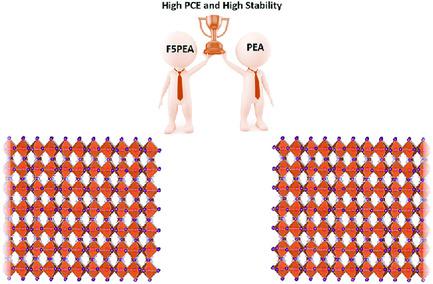Our official English website, www.x-mol.net, welcomes your feedback! (Note: you will need to create a separate account there.)
Enhancing Charge Transport of 2D Perovskite Passivation Agent for Wide‐Bandgap Perovskite Solar Cells Beyond 21%
Solar RRL ( IF 7.9 ) Pub Date : 2020-03-23 , DOI: 10.1002/solr.202000082 Jiselle Y. Ye 1, 2 , Jinhui Tong 1 , Jun Hu 3 , Chuanxiao Xiao 4 , Haipeng Lu 1 , Sean P. Dunfield 4, 5, 6 , Dong Hoe Kim 1 , Xihan Chen 1 , Bryon W. Larson 1 , Ji Hao 1 , Kang Wang 1 , Qian Zhao 1 , Zheng Chen 3 , Huamin Hu 3 , Wei You 3 , Joseph J. Berry 4 , Fei Zhang 1 , Kai Zhu 1
Solar RRL ( IF 7.9 ) Pub Date : 2020-03-23 , DOI: 10.1002/solr.202000082 Jiselle Y. Ye 1, 2 , Jinhui Tong 1 , Jun Hu 3 , Chuanxiao Xiao 4 , Haipeng Lu 1 , Sean P. Dunfield 4, 5, 6 , Dong Hoe Kim 1 , Xihan Chen 1 , Bryon W. Larson 1 , Ji Hao 1 , Kang Wang 1 , Qian Zhao 1 , Zheng Chen 3 , Huamin Hu 3 , Wei You 3 , Joseph J. Berry 4 , Fei Zhang 1 , Kai Zhu 1
Affiliation

|
The replacement of a small amount of organic cations with bulkier organic spacer cations in the perovskite precursor solution to form a 2D perovskite passivation agent (2D‐PPA) in 3D perovskite thin films has recently become a promising strategy for developing perovskite solar cells (PSCs) with long‐term stability and high efficiency. However, the long, bulky organic cations often form a barrier, hindering charge transport. Herein, for the first time, 2D‐PPA engineering based on wide‐bandgap (≈1.68 eV) perovskites are reported. Pentafluorophenethylammonium (F5PEA+) is introduced to partially replace phenylethylammonium (PEA+) as the 2D‐PPA, forming a strong noncovalent interaction between the two bulky cations. The charge transport across and within the planes of pure 2D perovskites, based on mixed ammoniums, increases by a factor of five and three compared with that of mono‐cation 2D perovskites, respectively. The perovskite films based on mixed‐ammonium (F5PEA+‐PEA+) 2D‐PPA exhibit similar surface morphology and crystal structure, but longer carrier lifetime, lower exciton binding energy, less trap density and higher conductivity, in comparison with those using mono‐cation (PEA+) 2D‐PPA. The performance of PSCs based on mixed‐cation 2D‐PPA is enhanced from 19.58% to 21.10% along with improved stability, which is the highest performance for reported wide‐bandgap PSCs.
中文翻译:

将宽带隙钙钛矿太阳能电池的2D钙钛矿钝化剂的电荷传输提高到21%以上
在钙钛矿前体溶液中用较大的有机间隔基阳离子替换少量有机阳离子,从而在3D钙钛矿薄膜中形成2D钙钛矿钝化剂(2D-PPA),已成为开发钙钛矿太阳能电池(PSC)的有前途的策略具有长期稳定性和高效率。但是,长而庞大的有机阳离子通常会形成障碍,从而阻碍电荷传输。在此,首次报道了基于宽带隙(≈1.68eV)钙钛矿的2D-PPA工程。引入五氟苯乙铵(F5PEA +)以部分替代苯乙铵(PEA +)作为2D-PPA,在两个庞大的阳离子之间形成很强的非共价相互作用。与单阳离子2D钙钛矿相比,基于混合铵的纯2D钙钛矿在平面内和平面内的电荷传输分别增加了5倍和3倍。与使用单铵盐的钙钛矿薄膜相比,基于混合铵(F5PEA + -PEA +)2D-PPA的钙钛矿薄膜具有相似的表面形态和晶体结构,但具有更长的载流子寿命,更低的激子结合能,更低的阱密度和更高的电导率。阳离子(PEA +)2D-PPA。基于混合阳离子2D-PPA的PSC的性能从19.58%提高到21.10%,并具有更高的稳定性,这是已报道的宽带隙PSC的最高性能。
更新日期:2020-03-23
中文翻译:

将宽带隙钙钛矿太阳能电池的2D钙钛矿钝化剂的电荷传输提高到21%以上
在钙钛矿前体溶液中用较大的有机间隔基阳离子替换少量有机阳离子,从而在3D钙钛矿薄膜中形成2D钙钛矿钝化剂(2D-PPA),已成为开发钙钛矿太阳能电池(PSC)的有前途的策略具有长期稳定性和高效率。但是,长而庞大的有机阳离子通常会形成障碍,从而阻碍电荷传输。在此,首次报道了基于宽带隙(≈1.68eV)钙钛矿的2D-PPA工程。引入五氟苯乙铵(F5PEA +)以部分替代苯乙铵(PEA +)作为2D-PPA,在两个庞大的阳离子之间形成很强的非共价相互作用。与单阳离子2D钙钛矿相比,基于混合铵的纯2D钙钛矿在平面内和平面内的电荷传输分别增加了5倍和3倍。与使用单铵盐的钙钛矿薄膜相比,基于混合铵(F5PEA + -PEA +)2D-PPA的钙钛矿薄膜具有相似的表面形态和晶体结构,但具有更长的载流子寿命,更低的激子结合能,更低的阱密度和更高的电导率。阳离子(PEA +)2D-PPA。基于混合阳离子2D-PPA的PSC的性能从19.58%提高到21.10%,并具有更高的稳定性,这是已报道的宽带隙PSC的最高性能。


























 京公网安备 11010802027423号
京公网安备 11010802027423号